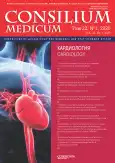HEART RHYTHM DISORDERS AND TOTAL CARDIOVASCULAR RISK AMONG MEMBERS OF LOCOMOTIVE CREWS WITH ARTERIAL HYPERTENSION
- Authors: Metso K.V.1,2, Nikiforov V.S.2
-
Affiliations:
- Department Hospital at Volkhovstroy Station
- Mechnikov North-Western State Medical University
- Issue: Vol 22, No 1 (2020)
- Pages: 44-48
- Section: Articles
- URL: https://journals.rcsi.science/2075-1753/article/view/95198
- DOI: https://doi.org/10.26442/20751753.2020.1.200062
- ID: 95198
Cite item
Full Text
Abstract
Full Text
##article.viewOnOriginalSite##About the authors
Kristina V. Metso
Department Hospital at Volkhovstroy Station; Mechnikov North-Western State Medical University
Email: metso.kr@gmail.com
аспирант каф. функциональной диагностики Санкт-Петербург, Россия
Viktor. S. Nikiforov
Mechnikov North-Western State Medical Universityд-р мед. наук, проф., проф. каф. функциональной диагностики Санкт-Петербург, Россия
References
- Вильк М.Ф. Пути организационно-методического обеспечения устойчивого финансирования железнодорожного здравоохранения в период реформирования. Экономика здравоохранения. 2002; 5-6: 53-5.
- Сериков В.В. Актуальные вопросы психофизиологического обеспечения безопасности движения на железнодорожном транспорте. Сб. науч. трудов ОНПЦ ПТ НУЗ «Научный клинический центр ОАО "РЖД"». М.: Т8 Издательские технологии, 2017.
- Марсальская О.А., Никифоров В.С. Изменения диастолической и систолической функции миокарда у работников железнодорожного транспорта с артериальной гипертензией. Вестн. Национального медико-хирургического центра им. Н.И.Пирогова. 2014; 9 (4): 48-51.
- Бондарев С.А., Василенко В.С. Кардиальная патология у машинистов железнодорожного транспорта. Сиб. мед. журн. 2011; 26 (2-1): 116-20. [
- Аверьянов А.В., Адрианов А.В., Ардашев А.В. и др. Внезапная сердечная смерть. Под ред. Е.В.Шляхто, Г.П.Арутюнова, Ю.Н.Беленкова, А.В.Ардашева. М.: Медпрактика-М, 2015.
- Никитин А.Э., Гришаев С.Л., Свистов А.С., Никифоров В.С. Электрическая нестабильность миокарда: причины, диагностика, лечение. СПб.: Вит-Принт, 2010.
- Шляхто Е.В., Арутюнов Г.П., Беленков ЮН и др. Национальные рекомендации по определению риска и профилактике внезапной сердечной смерти. 2-е изд. М.: Медпрактика-М, 2018.
- Никифоров В.С., Метсо К.В. Электрокардиографические предикторы внезапной сердечной смерти. Consilium Medicum. 2018; 20 (5): 29-33. doi: 10.26442/2075-1753_2018.5.29-33
- Национальные российские рекомендации по применению методики холтеровского мониторирования в клинической практике. Рос. кардиологический журн. 2014; 2 (106): 6-71.
- Williams B, Mancia G, Spiering W et al. 2018 ESC/ESH Guidelines for the management of arterial hypertension. Eur Heart J 2018; 39 (33): 3021-104.
- Piepoli MF, Hoes AW, Agewall S et al. 2016 European Guidelines on cardiovascular disease prevention in clinical practice: The Sixth Joint Task Force of the European Society of Cardiology and Other Societies on Cardiovascular Disease Prevention in Clinical Practice (constituted by representatives of 10 societies and by invited experts) Developed with the special contribution of the European Association for Cardiovascular Prevention & Rehabilitation (EACPR). Eur Heart J 2016; 37 (29): 2315-81.
- Gibbons RJ, Balady GJ, Bricker JT et al. ACC/AHA 2002 guideline update for exercise testing: summary article: a report of the American College of Cardiology/American Heart Association Task Force on Practice Guidelines (Committee to Update the 1997 Exercise Testing Guidelines). Circulation 2002; 106; 14: 1883-92.
Supplementary files






